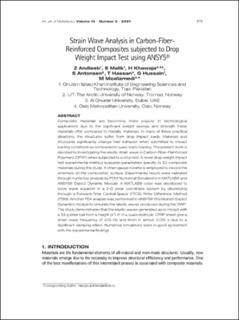| dc.contributor.author | Andleeb, Zahra | |
| dc.contributor.author | Malik, Sohail | |
| dc.contributor.author | Khawaja, Hassan | |
| dc.contributor.author | Antonsen, Ståle | |
| dc.contributor.author | Hassan, Taimur | |
| dc.contributor.author | Hussain, Ghulam | |
| dc.contributor.author | Moatamedi, Mojtaba | |
| dc.date.accessioned | 2021-09-28T15:37:15Z | |
| dc.date.available | 2021-09-28T15:37:15Z | |
| dc.date.created | 2021-07-11T04:09:29Z | |
| dc.date.issued | 2021-07-11 | |
| dc.identifier.citation | The International Journal of Multiphysics. 2021, 15 (3), 275-290. | en_US |
| dc.identifier.issn | 1750-9548 | |
| dc.identifier.uri | https://hdl.handle.net/11250/2784197 | |
| dc.description.abstract | Composite materials are becoming more popular in technological applications due to the significant weight savings and strength these materials offer compared to metallic materials. In many of these practical situations, the structures suffer from drop impact loads. Materials and structures significantly change their behavior when submitted to impact loading conditions as compared to quasi-static loading. The present work is devoted to investigating the elastic strain wave in Carbon-Fiber-Reinforced Polymers (CFRP) when subjected to a drop test. A novel drop weight impact test experimental method evaluates parameters specific to 3D composite materials during the study. A strain gauge rosette is employed to record the kinematic on the composites' surface. Experimental results were validated through numerical analysis by FDM Numerical Simulations in Matlab® and Ansys Explicit Dynamic Module. A MATLAB® code was developed to solve wave equation in a 2-D polar coordinate system by discretizing through a Forward-Time Central-Space (FTCS) Finite Difference Method (FDM). Another FEA analysis was performed in ANSYS® Workbench Explicit Dynamics module to simulate the elastic waves produced during the DWIT. The study demonstrates that the elastic waves generated upon impact with a 33 g steel ball from a height of 1 m in a quasi-isotropic CFRP sheet give a strain wave frequency of 205 Hz and finish in almost 0.015 s due to a significant damping effect. Numerical simulations were in good agreement with the experimental findings. | en_US |
| dc.description.sponsorship | The publication charges for this article were funded by a grant from the publication fund of UiT-The Arctic University of Norway. | en_US |
| dc.language.iso | eng | en_US |
| dc.publisher | International Society of Multiphysics | en_US |
| dc.relation.ispartofseries | The International Journal of Multiphysics;Volume 15 · Number 3 | |
| dc.rights | Navngivelse 4.0 Internasjonal | * |
| dc.rights.uri | http://creativecommons.org/licenses/by/4.0/deed.no | * |
| dc.subject | Composite materials | en_US |
| dc.subject | Carbon-fiber-reinforced polymers | en_US |
| dc.subject | Strain wave analyses | en_US |
| dc.subject | Numerical analyses | en_US |
| dc.title | Strain Wave Analysis in Carbon-Fiber-Reinforced Composites subjected to Drop Weight Impact Test using ANSYS® | en_US |
| dc.type | Peer reviewed | en_US |
| dc.type | Journal article | en_US |
| dc.description.version | publishedVersion | en_US |
| dc.rights.holder | Copyright (c) 2021 Z Andleeb, S Malik, H Khawaja, S Antonsen, T Hassan, G Hussain, M Moatamedi | en_US |
| cristin.ispublished | true | |
| cristin.fulltext | original | |
| cristin.qualitycode | 1 | |
| dc.identifier.doi | https://doi.org/10.21152/1750-9548.15.3.275 | |
| dc.identifier.cristin | 1921336 | |
| dc.source.journal | The International Journal of Multiphysics | en_US |
| dc.source.volume | 15 | en_US |
| dc.source.issue | 3 | en_US |
| dc.source.pagenumber | 275-290 | en_US |

